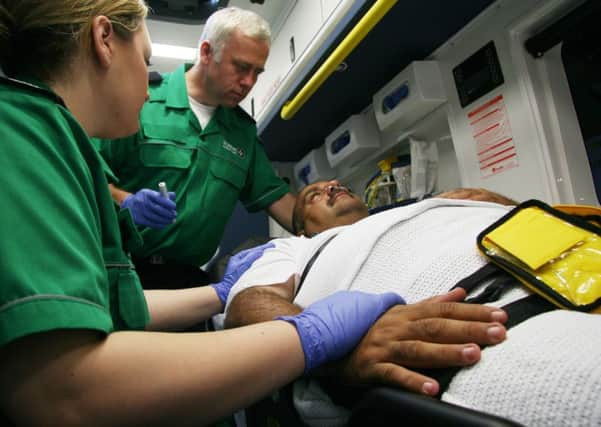ST JOHN AMBULANCE: How to monitor a casualty's vital signs


When treating a casualty you may need to monitor his vital signs; level of response, breathing and pulse.
This information can help to identify problems and indicate changes in the casualty’s condition.
Advertisement
Hide AdAdvertisement
Hide AdMonitoring should be repeated at regular intervals and the information handed over to paramedics when they arrive to take over.
Follow these simple steps to monitor vital signs:
• Asses the level of response using the AVPU scale and make any note of deterioration: A – Is the casualty Alert, does he respond to questions? V – Does the casualty respond to Voice commands? P – Does the casualty respond to Pain? Does he open his eyes or moved if pinched? U – is the casualty Unresponsive to any stimulus?
• When assessing a casualty’s breathing, check the rate of breathing and listen for any breathing difficulties or unusual noises. In adults, the normal rate of breathing is 12-16 breaths per minute; in babies and young children it is 20-30 breaths per minute.
• Listen for breaths and watch the casualty’s chest movements. For a baby or young child it may be easier to gently place your hand on the chest and feel for movement
Advertisement
Hide AdAdvertisement
Hide Ad• Record the following information: Rate – count the number of breath per minute; Depth – are the breaths deep or shallow? Ease – are the breaths easy, difficult or painful? Noise – is the breathing quiet or noisy and if noisy, what type of noise?
• The pulse may be felt at the wrist (radial pulse) or the neck (carotid pulse). In babies, the pulse in the upper arm (brachial pulse) is easier to find. When checking a pulse use your fingers and press lightly against the skin, record the following: Rate – the number of beats per minute. The normal pulse rate in adults is 60-80 per minute. The rate is faster in children and may be slower in very fit adults; Strength – is the pulse strong or weak? Rhythm – is the pulse regular or irregular?
Although not a vital sign, you may also need to assess body temperature. You can feel exposed skin but for an accurate reading, use a thermometer. A normal body temperature is 37°C (98.6°F).
A temperature above this is usually caused by an infection but can be the result of heatstroke or heat exhaustion. A lower body temperature may result from cold or wet conditions.
Advertisement
Hide AdAdvertisement
Hide Ad• For those looking for quick, easily accessible first aid information, the St John Ambulance app is available free on smartphones and the website (www.sja.org.uk) offers demo videos, an interactive game, and lots of free advice. For more information about first aid courses please call 0303 003 0101.
---
Don’t miss out on all the latest breaking news where you live.
Here are four ways you can be sure you’ll be amongst the first to know what’s going on.
1) Make our website your homepage
2) Like our Facebook page
3) Follow us on Twitter
4) Register with us by clicking on ‘sign in’ (top right corner). You can then receive our daily newsletter AND add your point of view to stories that you read here.
And do share with your family and friends - so they don’t miss out!
Always the first with your local news.
Be part of it.